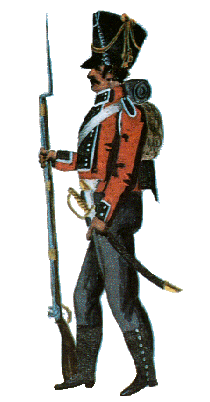





Oldenborgske Infanteri Regiment




| 3 battalions (1st, 2nd and 4th) and the light company of the 3rd battalion took part
in the campaign. The Danish musketeer wore a red jacket as seen on the picture. The
regimental color for Oldenborgske Infanteri Regiment was black, without edges. The
regimental color was on facings, cuffs, collar and turnbacks. Buttons were white. In 1810
the infantry went from darkblue pants to darkgrey. The winter uniform could be worn either
with black shoes or black bootlegs. The shako feather was white for the line companies and
short green feathers for the light companies. Cordons and tassels were yellow/red for the
line while the light troops wore green cordons and tassels. The picture is often incorrecly thought of as a Danish grenadier. He is not. The picture is well known and we even know the precise date when it was made.It is from the "Elberfeldmanuskriptet 1813-1814" and depicts a Danish line infantrist from the Holstenske Infanteri regiment, during the regiments stay in Elberfeld. The picture was made on the 15. march 1814. What could lead you to believe that the picture portraits a grenadier is the fact that the soldier is wearing a sabre, which looks remotely like a Grenadersabel M 1753. It might very well be a grenadier sabre, as musketeers were known to use these sabres as well as the grenadiers. The other thing that might mislead you is the fact that the soldier has a moustache, which was normally reseved for officers. This rule was rarely enforced, especially during campaigning. The regiment formed The Black Brigade along with the Oldenborgske Infanteri regiment as they both had black as regimental color. |
 |